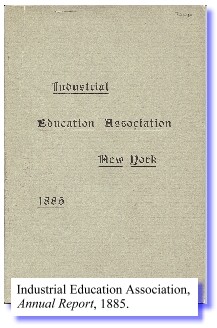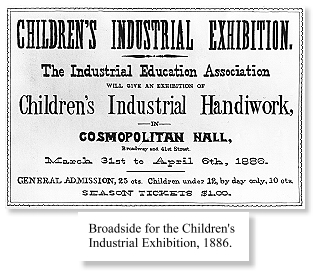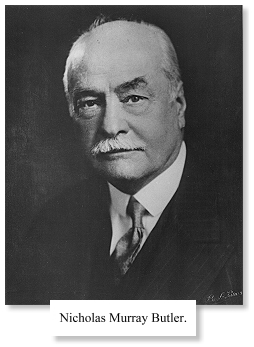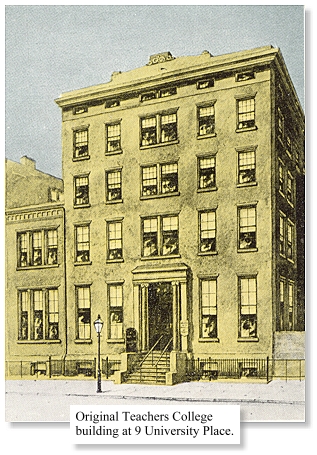 |
|
THE INDUSTRIAL EDUCATION ASSOCIATION
AND THE FOUNDING OF TEACHERS COLLEGE
Grace Dodge was not only a passionately committed social reformer, she was
an enterprising one at that. Between 1880 and 1887, Dodge, who was gifted in
her ability to plan for the future, laid the building blocks for the
establishment of Teachers College.
It was only a few years after its founding in 1880 that Dodge and the group
of women who administered the Kitchen Garden Association (KGA) recognized that
the organization had outgrown its original philanthropic mission to teach poor
girls the fundamentals of domestic service based on a popular instructional
model of kindergarten education. In the context of the growing support of the
manual training movement among social reformers and leaders in education during
this period, Dodge orchestrated the redesign of the KGA, which was subsequently
renamed the
 Industrial Education
Association (IEA) in 1884. Among other goals, the IEA aimed to provide
instruction in the industrial arts for both sexes and to make the industrial
arts (including the manual arts and the domestic arts) an integral part of
public education. Industrial Education
Association (IEA) in 1884. Among other goals, the IEA aimed to provide
instruction in the industrial arts for both sexes and to make the industrial
arts (including the manual arts and the domestic arts) an integral part of
public education.
Given the new objectives of the association and the broad resources required
to realize them, Dodge and her associates recognized the need for male support
and actively recruited men to participate in the administration and governance
of the IEA. While several prominent New York business and professional leaders
agreed to serve on the association’s Board of Managers, William Dodge,
Jr., Grace’s father, Frederick A. P. Barnard, who was president of
Columbia College and Seth Low, who was the mayor of Brooklyn, were made
honorary members. Alexander Webb, who was president of the College of the City
of New York, was appointed president of the IEA; though, Grace Dodge, who was
designated vice-president, assumed the active leadership role.
Dodge ably directed the IEA. Having grown up in a family that controlled
large, sophisticated business concerns, she learned to think in terms of growth
and expansion. Hence she made big, ambitious plans for the IEA, which,
supported primarily by donations and subscriptions, grew rapidly. The steady
rate at which the IEA expanded its programs and activities continually placed
the organization, in fact, in the position of searching for larger facilities
to accommodate its services. That came to an end in the summer of 1886 when
Dodge secured a permanent home for the IEA in the old Union Theological
Seminary Building at 9 University Place in Greenwich Village.
From its headquarters there, the IEA offered a wide range of services,
becoming in Dodge’s words, "a center of agitation, of information
and of organization." Among other activities, the IEA sponsored classes in
the industrial arts for public school children, training classes for teachers
in industrial education, public lectures on topics related to the manual and
domestic arts, and classes in the domestic arts for adult women. In addition,
the IEA functioned as a bureau of information about industrial education. It
published and disseminated articles about manual training and solicited and
organized information on the subject from sources across the country. According
to the association’s official reports, hundreds of people from all parts
of the country came to the offices of the IEA in search of information about
training in the manual and domestic arts.
One of the association’s main objectives was to stir public interest
in industrial education.
 With that in mind, the IEA
in 1886 sponsored the Children’s Industrial Exhibition at Cosmopolitan
Hall, on the corner of 41st and Broadway. A great success, the
exhibition, which, was open for seven days, received seven thousand visitors,
displayed work in industrial education from seventy different schools,
organizations and agencies in New York City and the surrounding region, and
attracted significant notice by the New York press. With that in mind, the IEA
in 1886 sponsored the Children’s Industrial Exhibition at Cosmopolitan
Hall, on the corner of 41st and Broadway. A great success, the
exhibition, which, was open for seven days, received seven thousand visitors,
displayed work in industrial education from seventy different schools,
organizations and agencies in New York City and the surrounding region, and
attracted significant notice by the New York press.
Among the issues discussed in the press was the fact that the New York City
public schools were not represented among the institutions displaying work in
the exhibition at Cosmospolitan Hall. Despite the success of the IEA’s
efforts to promote industrial education, the New York City public schools had
remained more or less indifferent to training in the manual and domestic arts
as a curricular innovation.
In an attempt to assuage public concern that the New York public schools
were not keeping pace with this trend in education, Mayor William R. Grace (who
had known Grace Dodge since she was a child) in 1886 appointed her and Mary
Nash Agnew, the wife of a Columbia College trustee, as the first female members
of the New York City Board of Education. Dodge served on the board for three
years, during which time she investigated the
 maintenance of school buildings, made
recommendations for the adoption of textbooks, addressed inequities in the
salaries paid to female teachers, and avidly promoted industrial education. maintenance of school buildings, made
recommendations for the adoption of textbooks, addressed inequities in the
salaries paid to female teachers, and avidly promoted industrial education.
Shortly after her appointment to the Board of Education, Dodge, intent on
keeping the IEA on the cutting edge of reform, restructured the association to
support a shift in its goals and purposes. A shortage of trained teachers in
industrial education, a problem of immediate concern to the IEA and one it was
intent on helping to resolve, specifically reshaped the association’s
mission in terms more specific to the goals of public education. It was
abundantly clear to Dodge that the IEA had transcended its role as a
philanthropic reform organization. Feeling unqualified to lead the IEA at this
juncture, Dodge relinquished a good part of her executive duties, deferring to
the IEA’s new salaried president, Nicholas Murray Butler, who was
appointed in February 1887.
Butler, who, prior to his appointment to the presidency of the IEA was an
associate professor of philosophy at
 Columbia College, had been preparing for a career in education, had
grand plans for the transformation of the IEA into a reputable educational
institution dedicated to the professional training of teachers and the study of
education. In line with his plans, the IEA soon evolved into the New York
College for the Training of Teachers, which, one year after Butler’s
resignation from the presidency in 1891, became Teachers College. In the years
following Butler’s resignation, Teachers College moved from its home at Columbia College, had been preparing for a career in education, had
grand plans for the transformation of the IEA into a reputable educational
institution dedicated to the professional training of teachers and the study of
education. In line with his plans, the IEA soon evolved into the New York
College for the Training of Teachers, which, one year after Butler’s
resignation from the presidency in 1891, became Teachers College. In the years
following Butler’s resignation, Teachers College moved from its home at
 9 University
Place to a new campus, adjacent to Columbia University on Morningside
Heights, and Grace Dodge once again assumed a leading role in the institution
she had built from the ground up. 9 University
Place to a new campus, adjacent to Columbia University on Morningside
Heights, and Grace Dodge once again assumed a leading role in the institution
she had built from the ground up.
Return to ("Table of Contents")
|





